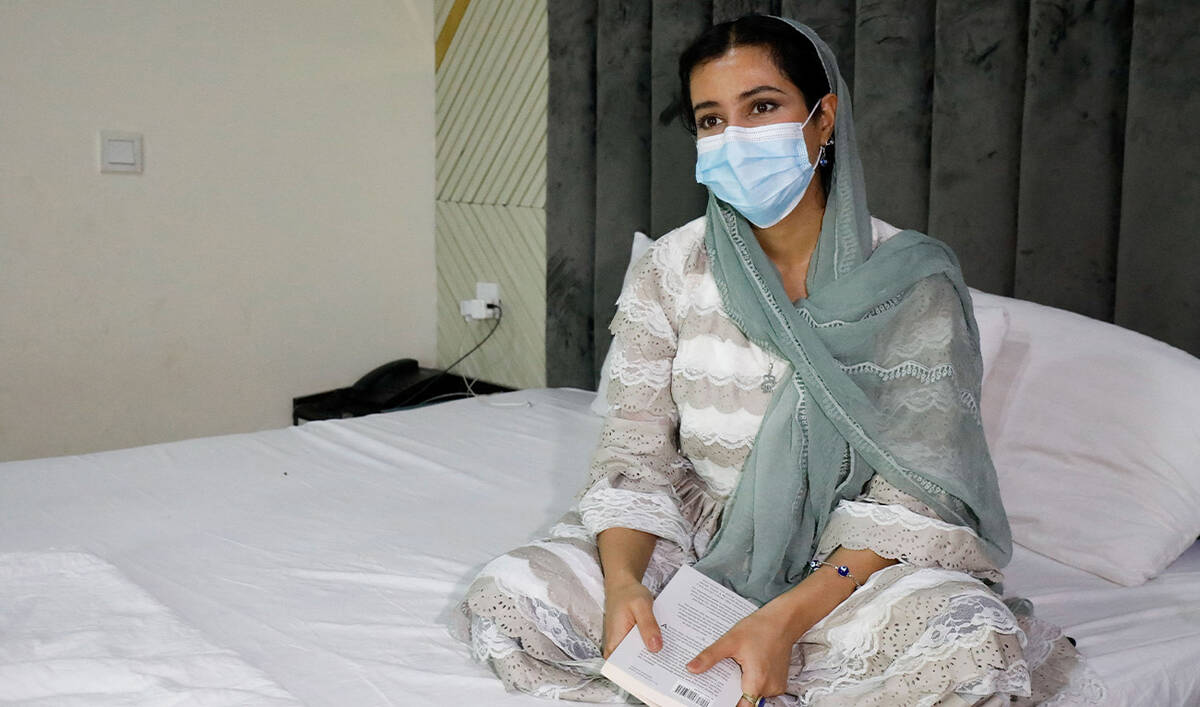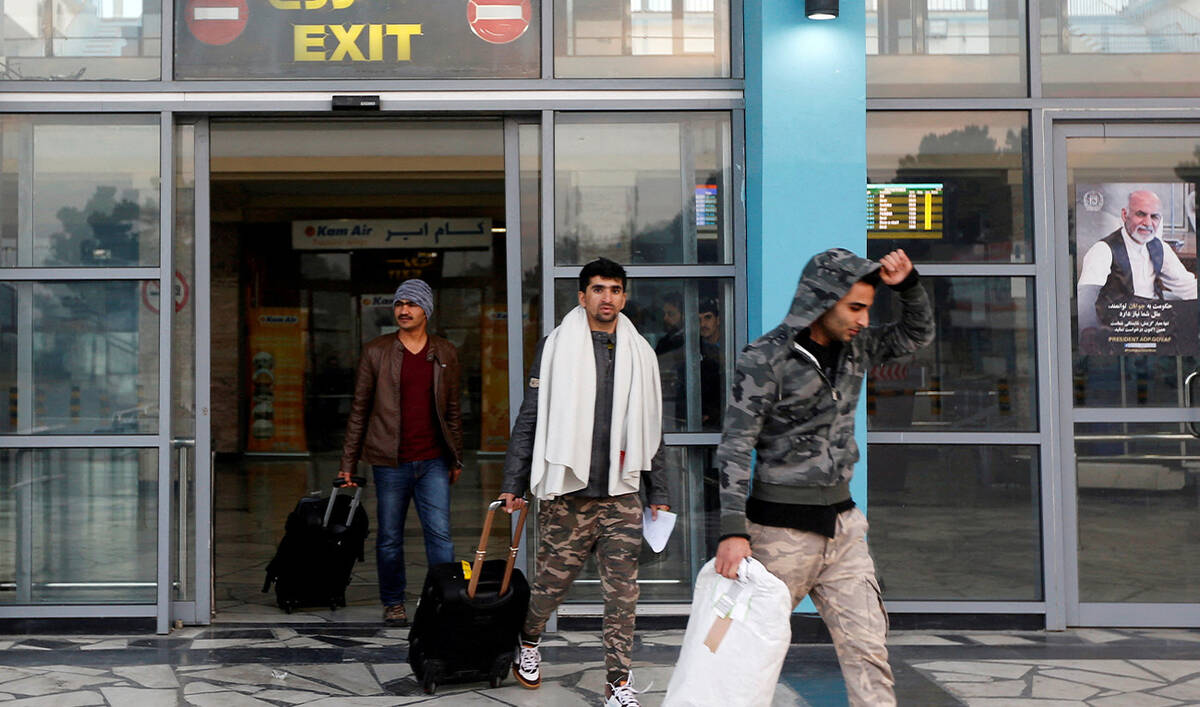BERLIN/ISLAMABAD: In a cramped guesthouse in PakistanŌĆÖs capital, 25-year-old Kimia spends her days sketching women ŌĆö dancing, playing, resisting ŌĆö in a notebook that holds whatŌĆÖs left of her hopes.
A visual artist and womenŌĆÖs rights advocate, she fled Afghanistan in 2024 after being accepted on to a German humanitarian admission program aimed at Afghans considered at risk under the Taliban.
A year later, Kimia is stuck in limbo.
Thousands of kilometers away in Germany, an election in February where migration dominated public debate and a change of government in May resulted in the gradual suspension of the program.
Now the new center-right coalition intends to close it.
The situation echoes that of nearly 1,660 Afghans cleared to settle in the United States, but who then found themselves in limbo in January after US President Donald Trump took office and suspended refugee programs.
KimiaŌĆÖs interview at the German embassy which she hoped would result in a flight to the country and the right to live there, was abruptly canceled in April.
Meanwhile, Germany pays for her room, meals and medical care in Islamabad.
ŌĆ£All my life comes down to this interview,ŌĆØ she told Reuters. She gave only her artist name for fear of reprisal.
ŌĆ£We just want to find a place that is calm and safe,ŌĆØ she said of herself and the other women at the guesthouse.

Kimia, 25, an Afghan journalist and artist who was accepted into Germany's humanitarian admission program for vulnerable Afghans, now stranded in legal limbo, speaks with Reuters at a guest house where she is living, in Islamabad, Pakistan June 13, 2025. (Reuters/File)
The admission program began in October 2022, intending to bring up to 1,000 Afghans per month to Germany who were deemed at risk because of their work in human rights, justice, politics or education, or due to their gender, religion or sexual orientation.
However, fewer than 1,600 arrived in over two years due to holdups and the cancelation of flights.
Today, around 2,400 Afghans are waiting to travel to Germany, the German foreign ministry said. Whether they will is unclear. NGOs say 17,000 more are in the early stages of selection and application under the now dormant scheme.
The foreign ministry said entry to Germany through the program was suspended pending a government review, and the government will continue to care for and house those already in the program.
It did not answer ReutersŌĆÖ questions on the number of canceled interviews, or how long the suspension would last.
Reuters spoke with eight Afghans living in Pakistan and Germany, migration lawyers and advocacy groups, who described the fate of the program as part of a broader curb on Afghan asylum claims in Germany and an assumption that Sunni men in particular are not at risk under the Taliban.
The German government says there is no specific policy of reducing the number of Afghan migrants. However, approval rates for Afghan asylum applicants dropped to 52 percent in early 2025, down from 74 percent in 2024, according to the Federal Migration Office (BAMF).
POLITICAL SHIFT
Kabul fell to the Taliban in August 2021. Since May 2021 Germany has admitted about 36,500 vulnerable Afghans by various pathways including former local staff, the government said.
Thorsten Frei, chief of staff to GermanyŌĆÖs new chancellor Friedrich Merz, said humanitarian migration has now reached levels that ŌĆ£exceed the integration capacity of society.ŌĆØ
ŌĆ£As long as we have irregular and illegal migration to Germany, we simply cannot implement voluntary admission programs.ŌĆØ

An activist depicting Chancellor Friedrich Merz shows a broken "promise" lettering in a symbolic protest action for the continuation of visa issuance under the admission programs for vulnerable Afghans, in connection with the first wave of lawsuits against the Federal Foreign Office and the suspending and reassess all refugee programs of the German government, in Berlin, Germany June 20, 2025. (Reuters/File)
The interior ministry said programs like the one for Afghans will be phased out and they are reviewing how to do so.
|Several Afghans are suing the government over the suspension. Matthias Lehnert, a lawyer representing them, said Germany could not simply suspend their admissions without certain conditions such as the person no longer being at risk.
Since former chancellor Angela Merkel opened GermanyŌĆÖs borders in 2015 to over a million refugees, public sentiment has shifted, partly as a result of several deadly attacks by asylum seekers. The far-right Alternative for Germany party (AfD), capitalizing on the anti-migrant sentiment, surged to a historic second-place finish in FebruaryŌĆÖs election.
Afghans Reuters spoke with said they feared they were being unfairly associated with the perpetrators, and this was putting their own lives at risk if they had to return to Afghanistan.
ŌĆ£IŌĆÖm so sorry about those people who are injured or killed ... but itŌĆÖs not our fault,ŌĆØ Kimia said.
Afghan Mohammad Mojib Razayee, 30, flew to Germany from Cyprus in March under a European Union voluntary solidarity mechanism, after a year of waiting with 100 other refugees. He said he was at risk after criticizing the Taliban. Two weeks after seeking asylum in Berlin, his application was rejected.
He was shocked at the ruling. BAMF found no special protection needs in his case, a spokesperson said.
ŌĆ£ItŌĆÖs absurd ŌĆö but not surprising. The decision-making process is simply about luck, good or bad,ŌĆØ said Nicolas Chevreux, a legal adviser with AWO counseling center in Berlin.
Chevreux said he believes Afghan asylum cases have been handled differently since mid-2024, after a mass stabbing at a rally in the city of Mannheim, in which six people were injured and a police officer was killed. An Afghan asylum seeker was charged and is awaiting trial.

┬ĀAfghans, whose asylum applications have been rejected, arrive from Germany in Kabul airport,┬ĀAfghanistan┬ĀDecember 15, 2016. (Reuters/File)
ŌĆśYOU DONŌĆÖT LIVEŌĆÖ
Spending most days in her room, surrounded by English and German textbooks, Kimia says returning to Afghanistan is unthinkable. Her art could make her a target.
ŌĆ£If I go back, I canŌĆÖt follow my dreams ŌĆö I canŌĆÖt work, I canŌĆÖt study. ItŌĆÖs like you just breathe, but you donŌĆÖt live.ŌĆØ
Under Taliban rule, women are banned from most public life, face harassment by morality police if unaccompanied by a male guardian, and must follow strict dress codes, including face coverings. When security forces raided homes, Kimia said, she would frantically hide her artwork.
The Taliban say they respect womenŌĆÖs rights in accordance with their interpretation of Islamic law and local culture and that they are not targeting former foes.
Hasseina, is a 35-year-old journalist and womenŌĆÖs rights activist from Kabul who fled to Pakistan and was accepted as an applicant on to the German program.
Divorced and under threat from both the Taliban and her ex-husbandŌĆÖs family, who she says have threatened to kill her and take her daughter, she said returning is not an option.
The women are particularly alarmed as Pakistan is intensifying efforts to forcibly return Afghans. The country says its crackdown targets all undocumented foreigners for security reasons. PakistanŌĆÖs foreign ministry did not respond to request for comment on how this affects Afghans awaiting German approval.
The German foreign ministry has said it is aware of two families promised admission to Germany who were detained for deportation, and it was working with Pakistan authorities to stop this.
Marina, 25, fled Afghanistan after being separated from her family. Her mother, a human rights lawyer, was able to get to Germany. Marina has been waiting in Pakistan to follow her for nearly two years with her baby.
ŌĆ£My life is stuck, I want to go to Germany, I want to work, I want to contribute. Here I am feeling so useless,ŌĆØ she said.┬Ā












